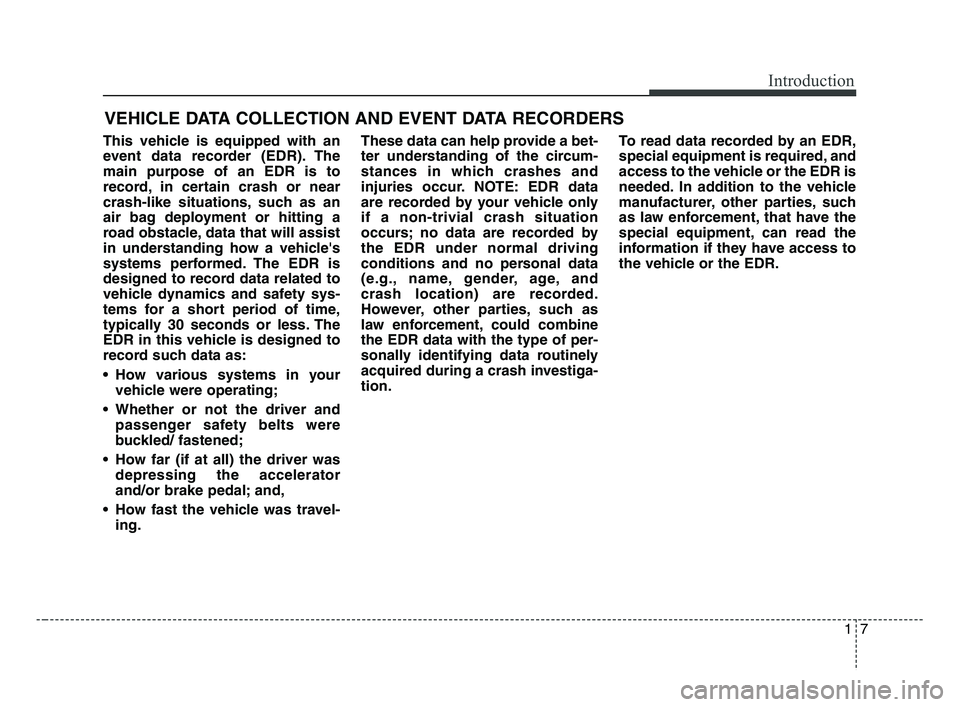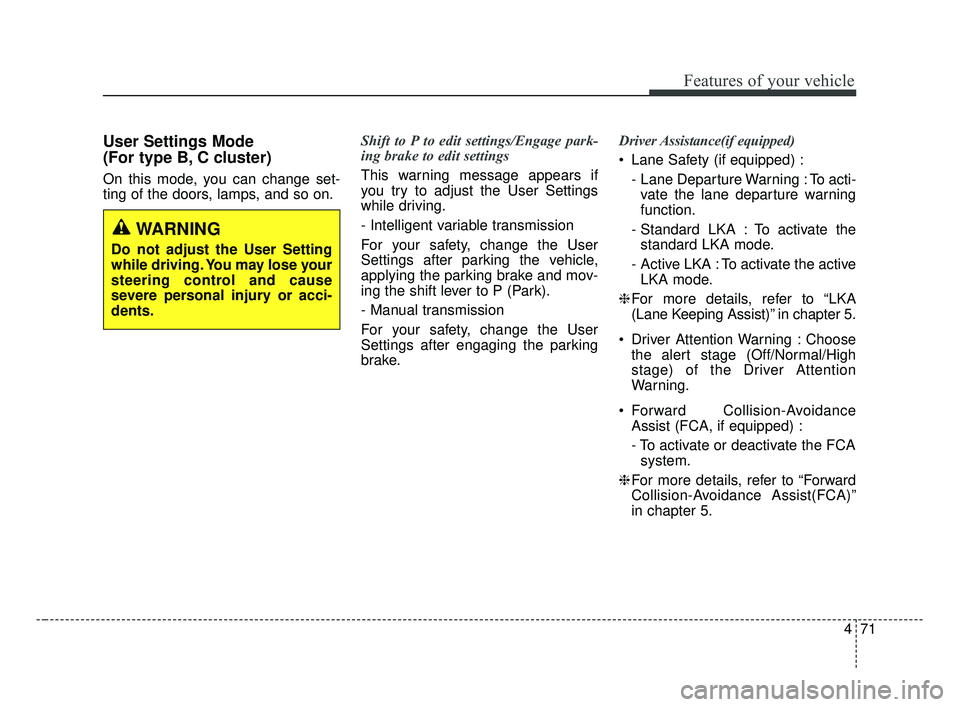Page 9 of 550
Introduction
6 1
No special break-in period is need-
ed. By following a few simple precau-
tions for the first 1,000 km (600
miles) you may add to the perform-
ance, economy and life of your vehi-
cle.
Do not race the engine.
While driving, keep your engine
speed (rpm, or revolutions per
minute) between 2,000 rpm and
4,000 rpm.
Do not maintain a single speed for
long periods of time, either fast or
slow. Varying engine speed is
needed to properly break-in the
engine.
Avoid hard stops, except in emer-
gencies, to allow the brakes to seat
properly.
Don't tow a trailer during the first
2,000 km (1,200 miles) of opera-
tion.
VEHICLE BREAK-IN
PROCESS
BDm CAN (ENG) 1.qxp 6/30/2018 1:38 PM Page 6
Page 10 of 550

17
Introduction
This vehicle is equipped with an
event data recorder (EDR). The
main purpose of an EDR is to
record, in certain crash or near
crash-like situations, such as an
air bag deployment or hitting a
road obstacle, data that will assist
in understanding how a vehicle's
systems performed. The EDR is
designed to record data related to
vehicle dynamics and safety sys-
tems for a short period of time,
typically 30 seconds or less. The
EDR in this vehicle is designed to
record such data as:
How various systems in your
vehicle were operating;
Whether or not the driver and
passenger safety belts were
buckled/ fastened;
How far (if at all) the driver was
depressing the accelerator
and/or brake pedal; and,
How fast the vehicle was travel-
ing.These data can help provide a bet-
ter understanding of the circum-
stances in which crashes and
injuries occur. NOTE: EDR data
are recorded by your vehicle only
if a non-trivial crash situation
occurs; no data are recorded by
the EDR under normal driving
conditions and no personal data
(e.g., name, gender, age, and
crash location) are recorded.
However, other parties, such as
law enforcement, could combine
the EDR data with the type of per-
sonally identifying data routinely
acquired during a crash investiga-
tion.To read data recorded by an EDR,
special equipment is required, and
access to the vehicle or the EDR is
needed. In addition to the vehicle
manufacturer, other parties, such
as law enforcement, that have the
special equipment, can read the
information if they have access to
the vehicle or the EDR.
VEHICLE DATA COLLECTION AND EVENT DATA RECORDERS
BDm CAN (ENG) 1.qxp 6/30/2018 1:38 PM Page 7
Page 14 of 550

Your vehicle at a glance
42
INTERIOR OVERVIEW
1. Inside door handle ............................4-20
2. Outside rearview mirror control ........4-53
3. Outside rearview mirror folding .........4-54
4. Central door lock switch....................4-21
5. Power window switch ........................4-30
6. Power window lock button ................4-34
7. Lane Keeping Assist system button..5-112
8. Steering wheel ..................................4-47
9. Tilt and telescopic steeringcontrol lever ......................................4-48
10. Instrument panel illumination control .............................................4-57
11. BCW ON/OFF button ....................5-102
12. Hood release lever ..........................4-35
13. Fuel filler lid release lever ...............4-38
14. Trunk release lever..........................4-24
15. Seat...................................................3-4
16. ESC OFF button .............................5-37
17. Brake pedal .....................................5-31
18. Accelerator pedal
19. Inner fuse panel ..............................7-55
OBDM018003N
BDm CAN (ENG) 2.qxp 6/30/2018 1:39 PM Page 4
Page 16 of 550
Your vehicle at a glance
62
ENGINE COMPARTMENT
OBD078101L
1. Engine coolant reservoir....................7-23
2. Engine oil filler cap ............................7-21
3. Brake/clutch fluid reservoir ................7-26
4. Air cleaner .........................................7-29
5. Fuse box ............................................7-55
6. Negative battery terminal ..................7-37
7. Positive battery terminal ....................7-37
8. Engine oil dipstick..............................7-21
9. Radiator cap ......................................7-23
10. Windshield washer fluid reservoir....7-27
❈ The actual engine compartment in the vehicle may differ from the illustration.
■ ■Nu 2.0L MPI Engine (Gasoline)
BDm CAN (ENG) 2.qxp 6/30/2018 1:39 PM Page 6
Page 83 of 550
367
Safety features of your vehicle
In an angled collision, the force ofimpact may direct the occupants in
a direction where the air bags
would not be able to provide any
additional benefit, and thus the
sensors may not deploy any air
bags. Just before impact, drivers often
brake heavily. Such heavy braking
lowers the front portion of the vehi-
cle causing it to “ride” under a vehi-
cle with a higher ground clearance.
Air bags may not inflate in this
“under-ride” situation because
deceleration forces that are detect-
ed by sensors may be significantly
reduced by such “under-ride” colli-
sions. Front air bags may not inflate in all
rollover accidents where the
SRSCM indicates that the front air
bag deployment would not provide
additional occupant protection.
OYG036079OBD038046OBD038052
BDm CAN (ENG) 3.qxp 6/30/2018 1:45 PM Page 67
Page 109 of 550
Features of your vehicle
24
4
Opening the trunk
1.Make sure the shift lever is in P
(Park, For Intelligent Variable
Transmission) or first gear or R
(Reverse, For Manual Transmission)
and set the parking brake. 2.Then do one of the following :
- Press the Remote key or SmartKey Trunk Unlock button for more
than one second.
- Press the button on the trunk itself with the Smart Key in your
possession.
- Use the mechanical key. (if equipped with key hole)
To open the trunk from inside thevehicle, pull the trunk lid release
lever.
Once the trunk is opened and then
closed, the trunk locks automati-
cally.
✽ ✽ NOTICE
In cold and wet climates, trunk lock
and trunk mechanisms may not work
properly due to freezing conditions.
TRUNK
OBD048040
OBDM048413N
OBDM048039N
■ Type B
■Type A
■Type C
BDm CAN (ENG) 4.qxp 7/4/2018 10:03 AM Page 24
Page 120 of 550
435
Features of your vehicle
Opening the hood
1. Pull the release lever to unlatchthe hood. The hood should pop
open slightly.
Open the hood after turning off the
engine on a flat surface, shifting the
shift lever to the P (Park) position for
Intelligent Variable Transmission and
to the 1st (First) gear or R (Reverse)
for Manual Transmission, and setting
the parking brake. 2. Go to the front of the vehicle, raise
the hood slightly, push the second-
ary latch (1) inside of the hood
center and lift the hood (2). 3. Pull the support rod from the
hood.
4. Hold the hood open with the sup- port rod.
HOOD
OBD048048
OBD048049OBDM048086N
WARNING - Hot parts
Grasp the support rod in the
area wrapped in rubber. The
rubber will help prevent you
from being burned by hot metal
when the engine is hot.
BDm CAN (ENG) 4.qxp 7/4/2018 10:04 AM Page 35
Page 156 of 550

471
Features of your vehicle
User Settings Mode
(For type B, C cluster)
On this mode, you can change set-
ting of the doors, lamps, and so on.Shift to P to edit settings/Engage park-
ing brake to edit settings
This warning message appears if
you try to adjust the User Settings
while driving.
- Intelligent variable transmission
For your safety, change the User
Settings after parking the vehicle,
applying the parking brake and mov-
ing the shift lever to P (Park).
- Manual transmission
For your safety, change the User
Settings after engaging the parking
brake.Driver Assistance(if equipped)
Lane Safety (if equipped) :
- Lane Departure Warning : To acti-vate the lane departure warning
function.
- Standard LKA : To activate the standard LKA mode.
- Active LKA : To activate the active LKA mode.
❈ For more details, refer to “LKA
(Lane Keeping Assist)” in chapter 5.
Driver Attention Warning : Choose the alert stage (Off/Normal/High
stage) of the Driver Attention
Warning.
Forward Collision-Avoidance Assist (FCA, if equipped) :
- To activate or deactivate the FCAsystem.
❈ For more details, refer to “Forward
Collision-Avoidance Assist(FCA)”
in chapter 5.
WARNING
Do not adjust the User Setting
while driving. You may lose your
steering control and cause
severe personal injury or acci-
dents.
BDm CAN (ENG) 4.qxp 7/4/2018 10:06 AM Page 71